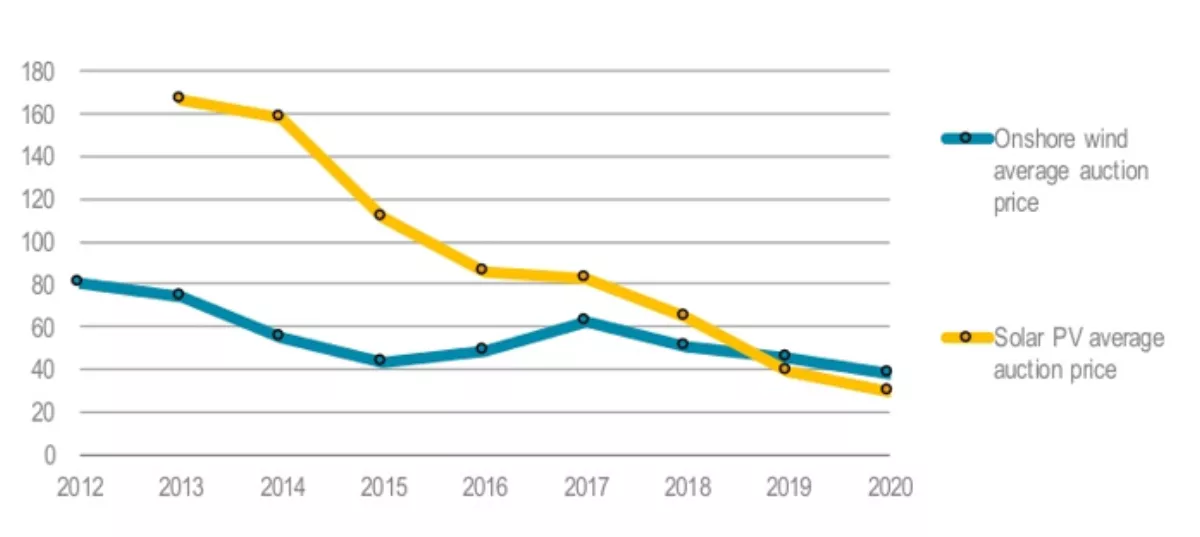
4 reasons cloud and colocation providers are going renewable
The boom in corporate renewable energy purchasing has impacted every industry, but nowhere is leadership stronger than in the information technology sector.
The largest and most innovative corporate purchasers inhabit this space, ranging from software (Microsoft, Salesforce, and Facebook) to hardware (Intel, Samsung, and Apple) to cloud-service and colocation providers (Amazon Web Services, Switch, and iomart).
What's driving this revolution and why should other cloud-service and colocation providers take notice?
1) Falling price through technology improvement and Ssale
One of the biggest motivations behind corporate renewable energy demand is cost. In the past decade, the price of renewables like wind and solar have fallen dramatically, bolstered by subsidization, but also due to the levelized cost of these technologies.
Unlike coal, oil, and natural gas—which depend on extraction—renewable energy generation gets cheaper over time as technology improves and scales.

Table 1 Falling costs perKW of solar and wind 2017-2022. Source: IEA.
The happy result is that renewable energy price, in many markets all over the world, is now competitive with more traditional fuel sources. Companies are reaping this benefit through offsite, utility-scale power purchase agreements (PPAs), which allow them to contract for generation at the source.
The flat-load nature of cloud-service and colocation provider demands means that there is even greater opportunity to save money on the retail electricity side, too, via direct PPAs—especially in the U.S. ERCOT and PJM interconnect markets.
2) Managing energy volatility with budget stability
Energy is a highly volatile and difficult to predict commodity. That can be tough for companies to budget for and manage, particularly during high-demand periods such as extreme weather fluctuations. Cloud-service and colocation providers are exposed to this volatility due to their need to operate consistently 24/7. Periods of electricity price surge—or worse, downtime—can challenge providers to maintain service at the level that their users expect.
Renewable energy PPAs can help companies manage price volatility by locking in a fixed-price for power, effectively hedging against volatility and resulting in budget stability.

Moreover, despite prevailing rhetoric that renewables penetration, and the inherent intermittency therein, destabilizes the grid, in reality, renewables are showing outstanding reliability. Data centers can benefit even further by islanded microgrids, capable of operating independently as needed, which further improves the reliability of electricity supply.
3) Differentiate yourself with renewable energy and meet the consumer demand
A key driver for cloud-service and colocation providers is customer expectation. Mounting pressures to get green mean that sustainability and carbon reduction have become an important consideration for most companies.
For those looking to host their operations in the cloud or in a colocation space, the ability to get green real estate—physical or digital—becomes a competitive differentiator.
But it's also a competitive differentiator for the cloud-service or colocation provider themselves, who can appear more desirable to these potential clients by offering space that is pre-greened.
Digital Realty and Iron Mountain have both responded to these pressures by making considerable investment in large-scale PPAs—the benefits of which they pass on to their customers.
In 2015, Digital Realty launched its Clean Start program, a first-of-its-kind structure under which the company provided customers with the carbon-free benefits of renewable energy. And in 2019, Iron Mountain took the concept a step further with the launch of its Green Power Pass, developed in conjunction with BSR's Future of Internet Power working group.
4) Environmental leadership drives renewable growth
Another competitive differentiator for providers is leading on environmental issues—namely carbon reduction.
Greenpeace's Clicking Clean report has driven action in the segment; the report scores companies on their actions around efficiency and renewable energy acquisition. For many, the goal is additionality—the ability to claim that it was their leadership that allowed new renewables to get built.
For other companies, innovation is key. These providers may be looking at supply chain engagement, or collaborative contracting structures similar to the one Salesforce recently executed alongside Bloomberg, Cox, Gap Inc., and Workday.

